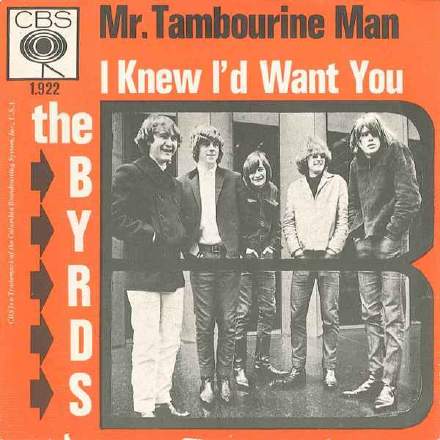
Returning to this, the band’s first hit, following the recent sad passing of David Crosby, I was fascinated to discover that the only member of the band who actually played on the record was apparently Roger McGuinn, the rest of the backing parts being provided by legendary sessioneers The Wrecking Crew. That said, McGuinn’s jangly 12-string Rickenbacker guitar certainly makes its presence felt, forming one of the linchpins of what was to become an era-defining folk-rock sound. It’s funny – this is one of those records where I think hindsight robs us of a sense of how revolutionary it was. What I mean is that so many bands subsequently aped this model of rock beat, jangly guitar, and moderately stoned-sounding vocal harmonies that it’s easy to forget that there was a time when it didn’t exist. And this song is one of the style’s founding documents, a pioneering attempt to package Dylan like the Beatles.
The song is, of course, a Bob Dylan cover, but one that was actually recorded a couple of months before Dylan’s own version had even been released (on the album Bringing It All Back Home) – they apparently became aware of the song from an unreleasable acetate demo of Dylan’s that had made its way into the hands of their manager Jim Dickson. But calling this a cover doesn’t really do justice to the liberties The Byrds took with the original materlal. For a start, they radically shortened it, by jettisoning three of Dylan’s four verses. Despite such swingeing cuts, though, their much lower tempo (about 45bpm slower) means that we still only get time for a single verse, leaving the song with a really odd structure if you think about it – how many other hits do you know with only two choruses, and a single verse between them? Notice also that the weird half-bar extension under “way, I promise to go” at 1:53 in the Dylan version has been smoothed out to a full bar by the Byrds at 1:24.
Another unusual aspect of this song that time has rather taken the edge off is the lyrics, which were extremely unusual for a number-one pop hit. To quote Crosby himself: “One thing we really did do is put really good lyrics on the radio for the first time. Up till then, [it was all] ‘ooh baby’. ‘To dance beneath the diamond sky with one hand waving free.’ Better. Much better lyric… You know, I think we did the other stuff right too, the guitars were right, the harmonies were good, and all that stuff, but I think the biggest push forward we made was to put that kind of lyrics, Bob’s lyrics, on the radio. Nobody’d ever done anything like that before.” Putting aside that the lyrics he quotes aren’t actually in the Byrd’s version, I can’t help but agree with the general sentiment.
From an engineering standpoint, this is one of those early stereo productions that provides interesting insights into the recording process. The ’either left or right’ panning of the backing offers the opportunity to listen deeper into the arrangement, for instance, and on soloing the left channel I for one was surprised to hear what sounds like some kind of electric piano padding out the harmonic texture once the right-panned drums and guitars are out of the picture – a sensible instrumentation choice to warm up a band texture centred so heavily around such a thin signature guitar sound (albeit already heavily compressed to add sustain). Also in the left channel, it sounds like there’s a single-tap sixteenth-note delay on the tambourine hits, an effect that I’m guessing would almost certainly have been created using a tape delay device of some kind, given the vintage.
Listening to the Sides signal, there seems to be a dusting of stereo reverb on the vocals too (I’d guess from a reverb chamber), and it’s probably worth pointing out that, contrary to what a lot of people seem to suggest, the famous vocal harmonies appear to be two-part, not three-part. Given that it seems from all the band’s live performances that three of the band were singing the choruses, the implication is that one of those two vocal lines must therefore have been double-tracked, but I really can’t make up my mind which one it is on the release version! Instinctively, I’d kind of expect it to be Roger McGuinn’s lower line, and the tone does somehow seem to take on a slightly ‘waterier’ double-tracked character for the choruses. But the high harmony feels so smooth and diffuse too somehow…










